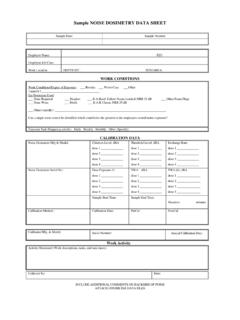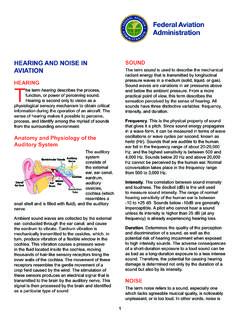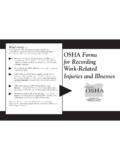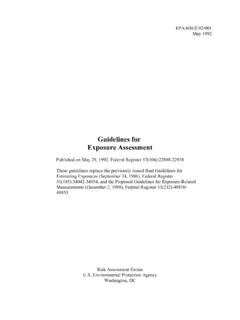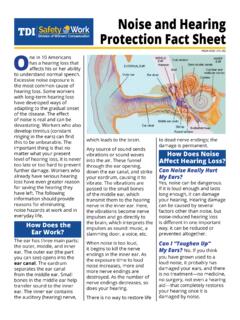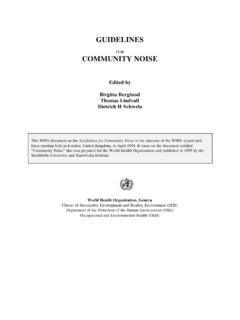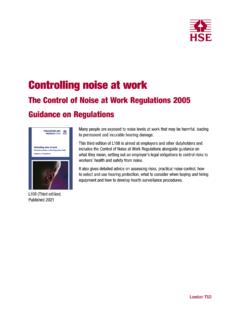Transcription of 4 EXPOSURE CRITERIA, OCCUPATIONAL EXPOSURE LEVELS
1 4 EXPOSURE criteria , OCCUPATIONAL EXPOSURE LEVELSDr JohnsonBr el, Bertrand, Johnson Acoustics Mile High , Utah 84604 USAFAX 001-901 224 P. Papadopoulos Dr N. Watfa and Dr J. TakalaMinistry of Labour & Social Security, OCCUPATIONAL Safety and Health BranchHead of Unit, SEPE Stadiou 29, International Labour Office (ILO)GR 101 10 Athens, Geneva 11 GREECE, SWITZERLANDFax: GENERAL CONSIDERATIONSA irborne sound can be described as propagating fluctuations in atmospheric pressure capable ofcausing the sensation of hearing.
2 In OCCUPATIONAL health, the term " noise " is used to denote bothunwanted sound and wanted sound as they can both damage hearing. noise -induced hearing losshas been recognized and reported for several hundred years. However, prior to about 1950,reliable dose-effect data were not available. Before World War II, due to lack of uniformity ininstrumentation and related units and scales, studies from various parts of the world often yieldedsignificantly different day American, European, and International standards (ANSI , ANSI , ANSI and IEC 60804-1985) relating to the instrumentation and methodologyof both noise and hearing acuity measurements are now in reasonable accord.
3 Recently, thisaccord resulted in an International Standard, ISO 1999-1990. This standard, although generallywell accepted internationally, is not universally accepted (Bies & Hansen 1990, Bies 1990, Clarkand Popeika 1989, Kraak et al. 1977 and Kraak 1981). It has been available for more than 12years for review. It is the standard that is the basis of the OCCUPATIONAL noise EXPOSURE limits, thetime-intensity trading relation, and the method for combining continuous noise with EXPOSURE criteria for the following sections and are an adaptation of thebackground documentation supporting the American Conference of Governmental IndustrialHygienists (ACGIH) OCCUPATIONAL EXPOSURE LEVELS (OEL).
4 However, the same criteria can alsobe used to support different criteria , OCCUPATIONAL EXPOSURE criteria FOR CONTINUOUS AND INTERMITTENT Introduction The statement in the OCCUPATIONAL EXPOSURE limit that the proposed OEL (85 dB(A)) will protectthe median of the population against a noise -induced permanent threshold shift (NIPTS) after 40years of OCCUPATIONAL EXPOSURE exceeding 2 dB for the average of , 1, 2, and 3 kHz comesfrom ISO-1999-1990. Specifically, Table provides median NIPTS values for a 40-yearexposure to 85 dB(A).
5 These values are 0, 0,2, and 5 dB for the audiometric frequencies of ,1, 2, and 3 kHz, respectively. Table provides the same data for a 40-year EXPOSURE to 90dB(A). These values are 0, 0, 6, and 12 dB for , 1, 2, and 3 kHz, respectively. The averagevalue for the audiometric frequencies of , 1, 2, and 3 kHz is dB. The correspondingaverage value for a 40-year daily EXPOSURE of 95 dB(A) is more than 10 : NIPTS values (dB) for a 40 year EXPOSURE to 85 dB(A). EXPOSURE Time, Yr102040 Frequency, NIPTS values (dB) for a 40 year EXPOSURE to 90 dB(A).
6 EXPOSURE Time, Yr102040 Frequency, 0 0 0 0000010000000000002000026248461300048137 1016912140007111591318111526000371248146 10181 EXPOSURE criteria , OCCUPATIONAL EXPOSURE levelsThe ISO 1999-1990 standard provides a complete description of NIPTS for various exposurelevels and EXPOSURE times. From these tables, it can be seen that there is clearly no fully obviouslevel at which to set the OEL. The 85 dB(A) limit for 8 hours is recommended by the ACGIHand has found acceptance in most countries. Because some countries still use 90 dB(A) or bothfor different steps of action and indeed the early OEL was at 90 dB(A), a short review of theACGIH recommending an A-weighted 8-hour equivalent level of 85 dB(A) is in Octave Band vs.
7 A-WeightingBefore 1950, overall sound pressure LEVELS , in decibels, were used to define the noise aspect ofdamage-risk criteria (Olishijski and Hartford 1975). Following recognition that the overallintensity of a noise by itself was not sufficient to describe the potential for damage, and that thefrequency characteristic must also be considered, criteria incorporating spectral LEVELS , usuallyoctave-band LEVELS , were 1954 different national and internationl committees discussed this 1961, the ISO/TC 43 discussed a series of noise rating curves and proposed that the noiserating curve, NR-85.
8 Be used as the limit for habitual workday EXPOSURE to broadband octave-band analysis is a relatively lengthy procedure requiring expensiveinstrumentation. There was some concern that the layman had difficulty in interpreting theresults. Recognizing the desirability of a single reading and the fact that most industrial data onNIPTS were available for single-weighted noise LEVELS , the Intersociety Committee, in 1967,proposed the use of A-weighted sound LEVELS in the development of criteria (Ad Hoc IntersocietyGuidelines 1967).
9 The A-weighted characteristic of a sound level meter is designed toapproximate the frequency selective response of the human ear at low sound pressure LEVELS . Inone report, Botsford demonstrated that A-weighted LEVELS are as reliable as octave-band levelsin the prediction of effects on hearing in 80% of the OCCUPATIONAL noises considered and slightlymore conservative (more protective) in 16% of the cases (Botsford 1967). Passchier-Vermeer(1968) and Cohen et al. (1972) similarly demonstrated that A-weighted LEVELS provide areasonable estimate of the hazard to hearing in most industrial environments.
10 The abbreviationdB(A) is used to denote decibels A-weighted and can be described as a unit of measurement ofsound level corrected to the A-weighted scale as defined in IEC 60651. Today, A-weighted soundlevels are in general use in hearing damage risk 85 dB(A) vs. 90 dB(A)Permanent noise -induced hearing loss is related to the sound pressure level and frequencydistribution of the noise , the time pattern and duration of EXPOSURE , and individual ability to hear and understand everyday speech under normal conditions is regarded as themost important function of the hearing mechanism.











